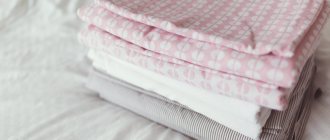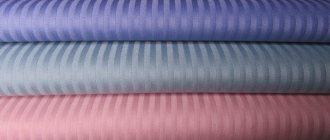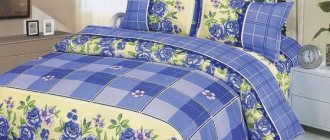Why you need to change your bed linen often
This is due to a number of factors:
- Hygiene. Sweat, skin particles, creams and body lotions - all this quickly stains the fabric. Many people have probably noticed that sleeping on a clean floor is much more pleasant. And it’s not just about the sensations, because clean fabrics smell and ventilate better. Therefore, sleep on clean sheets is always stronger and more peaceful.
- Dust mites live in large numbers in human beds. You won't be able to get rid of it forever, even if you want to. But if you regularly wash textiles at high temperatures, they will become noticeably smaller. Why do you need to get rid of dust mites? The fact is that common allergies to dust are caused by their waste products. Even if you have not previously suffered from itching, coughing, or other manifestations of allergies, over time it may develop.
- Bacteria, viruses, fungi Warmth and moisture from the body create favorable conditions for them to grow. The less often you change your bed linen, the more unwanted microorganisms live around. This can cause respiratory diseases, infections, etc.
How often should I wash it? It is recommended to do this at least once a week
In some cases, it may need to be washed more often.
How to wash bed linen?
We recommend washing sheets and other bedding in hot water, because the higher the temperature, the more bacteria and allergens you kill. For example, the patient needs to change bed linen frequently, as well as wash it at the highest temperature. Some harmful microorganisms are very tenacious and do not die at low temperatures. But remember, before washing you need to study the instructions on the label.
After washing, it is better to iron sheets, pillowcases and duvet covers. This is especially true for children. So, bedding for a newborn needs to be changed often, as well as cleaned in a more delicate mode with gentle powders.
If you change it rarely
Sleeping on dirty sheets has many negative consequences.
Changing pillowcases and duvet covers is a hassle: you need to take off the old set, wash, iron, and then put on a new one. This takes a lot of time, so many people prefer to postpone this procedure “for one more week,” and then for another 1, and so on. Unfortunately, sleeping on a dirty bed can have a number of negative consequences. If you rarely change it, prepare for:
- Increased risk of developing allergies. A dirty bed contains many dust mites. In the spring and summer, allergens also settle on the bed: pollen, plant particles. A stuffy nose, watery eyes, and itching will have a bad effect on the quality of your rest.
- Deterioration of skin and hair condition. During sleep, the skin is constantly in contact with the fabric. If it is dirty, it will have a bad effect on the condition of the skin: acne, rashes, inflammation will appear on it, and the skin will become oily. This is especially true for those who have problem skin.
- Increased risk of respiratory diseases and infections.
When to change bed linen: signs and days of the week
Of course, this issue is not without various signs and superstitions.
Many people are interested in which days they can change their underwear and which days they can’t.
People have a lot of signs about this, let’s take a look at some of the most common ones.
Is it possible to change bed linen on Sunday? Unfortunately no. Moreover, this day is considered the most unfavorable day for changing linen.
Although everything here is simple and easy to explain, because on this day Christian believers attend church services. On this day, it is customary not only not to change linen, but also not to work or clean. By the way, this rule applies to any other church holidays.
How to properly wash, dry and store sweaters
Friday is also considered a bad day. For some reason, this day promises nightmares and unhealthy sleep. Perhaps this is due to the fact that it is the end of the working week and there is no energy left for other things.
What's wrong with Monday, Tuesday and Wednesday? It has long been the custom that it was at the beginning of the week that women began washing things so that they had time to dry by the end of the week. This may explain the fact that it is not recommended to change your underwear these days. So, if you believe in omens, then it is better to wash your bed linen at the beginning of the week, as our grandmothers and great-grandmothers did. The ritual of washing clothes exclusively on Mondays is still preserved among the Old Believers even today. Of course, when you have a washing machine and dryer, this sign makes no sense at all.
When is the best time to change bed linen? We have two days left - Thursday and Saturday!
- Thursday is associated with Maundy Thursday in Rus' (the day when believers began preparing for Easter). It is on this day that it is customary to clean the house, change linens and prepare for the holiday.
- Saturday is also a great day to change your clothes. On this day, you can not only change your linen, but also clean the entire house. It is cleaning on this day that promises the newlyweds family well-being and love.
Here are a few more equally interesting signs related to underwear. The most common:
You can't sleep on wrinkled linen. In the old days, people believed that wrinkled linen attracted evil spirits, so they made sure to iron it.
Another sign is to wear your underwear inside out. But the same sign exists with clothes. It is believed that the wrong side symbolizes an unpleasant situation or blows of fate.
It was also believed that under no circumstances should you dry your clothes in the wind at night, otherwise you will have nightmares later.
Be sure to cover your bed with a blanket, otherwise there is a risk of getting sick. But for married couples, an unmade bed promised betrayal.
What factors influence the frequency of changing linen
The frequency depends on various factors: season, age, how much you sweat at night, whether you use night cosmetics, etc. In some cases, it needs to be re-laid just a few days after the first use. Let's consider the question in more detail.
Seasons
- In winter, it is allowed to remake the bed less often - once every two weeks. People do not open windows during this period, so allergens such as pollen or street dust cannot fly into the house and onto the sleeping bed. In winter, the rooms are not so hot, so the body does not produce as much sweat.
- In the spring, a lot of pollen and other allergens enter homes through open windows. If allergic reactions worsen at night, wash your sheets and other textiles twice a week.
- In summer, it is also better to do this more often than the accepted norm. In summer it gets hot even at night - this causes increased sweating.
- How often should I re-lay it in the fall? At this time of year, you can reduce the frequency to winter values.
Other reasons
8 reasons to make your bed more often
- Presence of pets.
Many owners of cats and dogs do not prohibit their pets from sleeping in their beds. Unfortunately, pets do not take care of hygiene as carefully as people, so fur, dirt, and bacteria get on the bed. If your pet likes to climb into bed, wash the bedding as often as possible—every few days. - If you are sick,
it is better to change it more often. Especially if there is an order to constantly lie in bed. The human bed is an extremely favorable environment for the growth of bacteria. A weakened body should not come into contact with germs. - Do you like to eat while lying in bed?
Even the most careful eater will leave a few crumbs in the bed. Just accept this fact and try not to eat in bed. If it is impossible to break the habit, you will have to remake the bed after a meal so as not to turn it into a “buffet” for bacteria. - for people with excessive sweating
to change it more often - increased humidity causes accelerated growth of bacteria. Also in this case, it is recommended to use waterproof mattress covers. - Do you actively use skin lotions and night cosmetics?
If you use products on your face, you can simply wash your pillowcases regularly or place a clean towel on your pillow every day. If you have to apply creams to the body, it is better to increase the frequency of replacing the entire set. In this case, we also recommend waterproof mattress covers so that the components of the cream do not stain the mattress cover and become a breeding ground for bacteria. - An allergy to house dust
is a reason to wash textiles and mattress covers more often. When changing sheets, a lot of dust gets into the air; it is better to wear a respirator. - If you prefer to sleep naked
, you also need to wash your sleeping accessories regularly. - Age
. Children need to change their bedding more often than adults. Newborns need to remake their sleeping bed once a day, children from 2 years to 12 - twice a week. Teenagers are also advised to change their kit to a fresh one more often due to increased sweating. About once every 4 days. To reduce problems with your facial skin, wear new pillowcases more often.
What determines the frequency of changing bed linen?
Alas, there are still people who believe that bed linen should be washed only when it gets dirty - visually dirty. In fact, we cannot see most of the pollution, especially dangerous to humans. Moreover, they appear much faster than those that are visible to the human eye.
So, here is a modest list of the treasures hiding on your sheets:
- dust (you can’t even imagine in what quantities);
- pet hair, if any;
- sweat;
- secretions of the sebaceous glands;
- dead skin cells;
- dandruff;
- dust mites. If you have carefully examined your bed and did not find any swarming insects there, you should not hastily rejoice that these creatures have passed you by. Dust mites are microorganisms; they do not bite and are not in themselves dangerous to humans. But the products of their vital activity greatly affect the human condition.
All of the above points create a favorable environment for the proliferation of microbes.
Articles on the topic (click to view)
- Fences for parking lots and parking areas
- Selection of reinforced concrete columns
- Linen bed linen: pros and cons, selection rules
- 5 ways to make your interior more expensive
- Cleaning upholstered furniture
- How to choose bed linen?
- Side for baby's crib
During sleep, we are in close contact with bedding: we breathe all its contents (from banal dust to dangerous fungi - these are the most advanced cases), and also collect all these riches with our skin.
What consequences await the owner of this fauna in his sleeping place?
- Acne – simply put, pimples. One of the main causes of acne is bacteria. So, if you've tried absolutely everything, but your face is still plagued with acne, try changing your pillowcase more often. Just think about it: lying on a pillow, you press your face into a whole jungle of parasites with daily approaches of 6-8 continuous hours. Should we later wonder where the new hated pimples come from?
- Dermatitis is another skin disease, but it is caused by an allergic reaction and manifests itself on absolutely any part of the body in the form of inflammation and crusting. All this beauty comes with an itch as a gift. Allergies are caused by the secretions of linen mites and dust.
- Allergy - in its broader sense, which is accompanied not only by inflammation of the skin: here you have watery eyes, sneezing and nasal congestion - the whole set.
- Rhinitis - in other words, a runny nose. If you don’t suffer from allergies or have a cold, but still wake up with a stuffy nose, it’s time to urgently organize a big laundry day by updating your bedding set.
Surprisingly, the presence of all these diseases is determined simply by how often you change your bed linen.
The following points no longer look so scary, but there is little pleasant in them either:
- Difficulties with washing: the longer you put it off, the more difficult it will be to remove stains (especially grease) and the living creatures you already know. Result: ugly, yellow, discolored laundry.
- Unpleasant odor from bed linen.
Tips for every day
- Take your time to cover the bed with a blanket or remove pillows and blankets immediately after sleep. Give them time to air out and dry. If the weather permits, leave the window open.
- Wash bed linen at a temperature of at least 60 degrees. Not every set (especially cheap ones) can withstand frequent washing, so buy quality sets that can be washed at high temperatures. Consider whether you need expensive sets made from premium fabrics that look good but can be cleaned on a gentle low-heat cycle. Washing at a low temperature will not kill all bacteria and mites.
- Natural fabrics are preferable - they breathe better and absorb moisture, which quickly evaporates.
- If possible, try to iron textiles after washing. High temperatures are even more effective at killing microorganisms that can survive bathing in a washing machine.
- Don't go to bed with wet hair. This not only causes bacterial growth, but also ruins the filling of the pillow. Especially if there is fluff or feathers inside it.
- Buy several sets at once. This will save you from a situation where the old one has already been sent to the basket, but there is no new one in the closet.
How often should you change your bed?
The frequency of bedding replacement is described in SanPiNs developed for hospitals, kindergartens, dormitories, holiday camps, and sanatoriums. At home, the same standards apply.
To maintain the sanitary and epidemiological well-being of the population:
- bedding is beaten and dried monthly;
- blankets and pillows are washed every 3-4 quarters;
- a dirty set of linen is removed every 7 days;
- Pillowcases are changed 1-3 times a week.
But there are exceptions for children of different ages and people with various diseases.
To view the doctor's opinion:
For adults
Physiology plays a major role in the frequency of changing bedding sets.
How often are adults advised to remake their bed:
- for sexually mature people without dysfunction of organs or glands, it is enough to change their underwear every 5–7 days;
- An accidentally soiled product from the kit is removed immediately;
- in case of increased sweating due to menopause, endocrine diseases or other physiological factors, excessively damp bedding is dried or changed in the morning.
There is an unwritten rule of bedding hygiene that concerns the intimate side of life and comfort. Linen is changed before a planned romantic meeting and the morning after it.
For teenagers
As a child grows, his hormonal levels change. Age-related changes are often difficult: with increased sweating, irritation, and inflammation of the skin. Boys have wet dreams, girls have irregular periods.
At home, for the comfort and health of adolescents, their bedding is removed every 3–4 days. The set is covered after knocking out the pillows and blankets. It is better to wear clean pillowcases every day. This reduces the severity of acne.
In camps, sanatoriums or other children's institutions, bedding is changed according to SanPiN 2.4.4.3155-13. Clean linen and towels are provided weekly before the weekend, as well as upon request in case of early soiling.
Newborn children
A clean bed, diaper and clothing protect babies from dermatitis, fungal infections, bacterial infections, and pustules. In newborns, immunity has not yet developed, digestion is normalized, and the skin is especially sensitive.
Newborns often get things dirty:
- regurgitated milk;
- saliva;
- urine;
- feces.
It is advisable for babies to place a fresh diaper on top of the sheets before going to bed in the first 4 weeks. Contaminated items are changed immediately. For children 2–5 months old, bedding is removed after 1–2 days. From six months the set is re-dressed every 3-5 days.
According to the recommendations of pediatricians, a waterproof layer is placed between the mattress and the sheet. From birth to one year, a child's clothes and bedding are ironed. Wash the blanket and headrest/pillow weekly with baby powder.
Children from 2 years old
At home, a child under three years old has his bed sheets changed every 4–5 days. In kindergartens, according to the norm in SanPiN 2.4.1.3049-13, sets are re-made weekly.
Replace linen ahead of schedule if contamination is detected. Parents can ask to change the bed on the day the baby arrives at kindergarten after an infectious disease.
For allergy sufferers and sick people
For acute respiratory viral infections and influenza, the linen is changed every 1-2 days until the person recovers.
People's bed sheets are changed daily:
- with infectious diseases of the skin/hair/nails;
- with intestinal parasite infection.
After recovery, bedding continues to be changed frequently for the first 3–7 days. Then they switch to the 1 time/week schedule.
How often are linens changed in medical institutions?
- in the surgical department - a clean set is laid out upon admission and before surgery, changed as it gets dirty, but at least once a week;
- in other departments of the hospital - they are covered before the patient’s admission, changed weekly during treatment;
- in the maternity hospital - reposition every 3 days;
- in intensive care wards - for a seriously ill patient, the sheet is straightened 2-3 times a day, shaken off, contaminated items are removed, linen is changed 1-2 times a week.
Allergy sufferers are advised to wash out their utensils and change their laundry weekly. People with dust sensitivity are advised to change their pillowcases daily.
Depending on the time of year
Regardless of the season, bedding is changed according to SanPiN standards: weekly. It is advisable to increase the frequency only in summer and in countries with hot climates. Under these conditions, the linen is rearranged after 2–3 days.
Video of what an esotericist thinks about changing underwear:
Rules for caring for bed linen
A few simple tips for proper care of bedding fabrics.
Sheets
Do not place sheets on top of a mattress or sofa. We recommend using mattress protectors. For what? This is a kind of protective barrier that will help keep the mattress cover or sofa upholstery clean and reduce the amount of dust on them. Thanks to the fact that mattress covers are easier to wash, you can keep your sleeping area clean more effectively.
When washing, use a 60 degree setting (if the fabric allows) and do not use a lot of powder. To completely remove any detergent residue, use a double rinse. Powder residue may cause allergies.
Pillowcases
Before washing, you must turn all pillowcases inside out. This will preserve the pattern and color longer. Afterwards, it is recommended to iron the items with an iron if the fabric cannot be washed at high temperatures.
It is recommended not to use bleach and spin textiles at 500-600 rpm.
Types of bed linen
The most common types:
- Satin. It is a dense material made of linen or cotton. The back side is rough, and the front side is smooth. This is achieved using a special thread weave. The fabric can absorb moisture, which is considered a good property for a bedding set. The sheet absorbs sweat in hot weather. The material does not allow heat to pass through. Under a satin blanket, the optimal temperature will be maintained in summer and winter. It is wear-resistant, the shade does not change after 200 washes. The fabric is not easy to crumple, it is environmentally friendly and does not lead to allergic reactions. Disadvantages: not everyone appreciates the smoothness of the linen; cotton sleepwear is needed.
- Percale. Made from linen, cotton or a mixture of the latter and polyester. The fabric is lightweight yet durable. It will endure up to 1000 treatments. The material is smooth, which is not suitable for everyone.
- Turkish silk. It is inferior to the Japanese version in terms of strength, but has many advantages. The fabric is very beautiful, it has bright colors. It cools in hot weather. The linen is made from natural raw materials, so it does not lead to allergic reactions. It is pleasant to the touch and does not wrinkle. It has a long service life and is chosen for an expensive gift.
- Viscose. It is an artificial material made from cellulose. It is of no less quality than natural fabrics such as wool, linen, cotton, silk. Viscose is soft, light and hygienic. It absorbs moisture twice as much as cotton, does not electrify and is perfectly breathable.
- Microfiber. An artificial fabric that is 100% polyester. It is soft and fits nicely to the body. Almost does not lose shades and does not fade, and is easy to wash. The material is wear-resistant, so it will last a long time.
- Batiste. Eco-friendly fabric, made from linen or cotton. It has the lowest density of thread weaving. This gives it silkiness, lightness, and translucency. Moisture is perfectly absorbed, does not lead to allergic reactions, the material is durable. It is delicate and requires special care.
- Bamboo. It is soft, similar in quality to cashmere, and has a natural shine. Has antibacterial properties that remain for a long time. The set is durable, but it requires special care.
- Calico. One of the most popular options for bedding sets. It's cotton, it's practical. It is difficult to wrinkle, the shade lasts for a long time, and washes well. The fabric is environmentally friendly and perfectly absorbs moisture.
- Linen. Natural material, medium density thread weaving. It is durable, hygienic, and due to its special structure you can feel a slight massage effect. Body temperature is perfectly maintained, and moisture is quickly absorbed and evaporated. After several washes, this set becomes soft and pleasant to the touch.
- Chintz. Rarely woven cotton material. It is common due to its low price. At the same time, the quality is high, it is smooth, light, and durable.
- Flannel. Warm natural fabric made entirely of cotton. It fits nicely to the body and has a light fluff. It withstands washing very well and becomes even more soft. It is durable and easy to maintain. Disadvantage: not suitable for warm weather.











